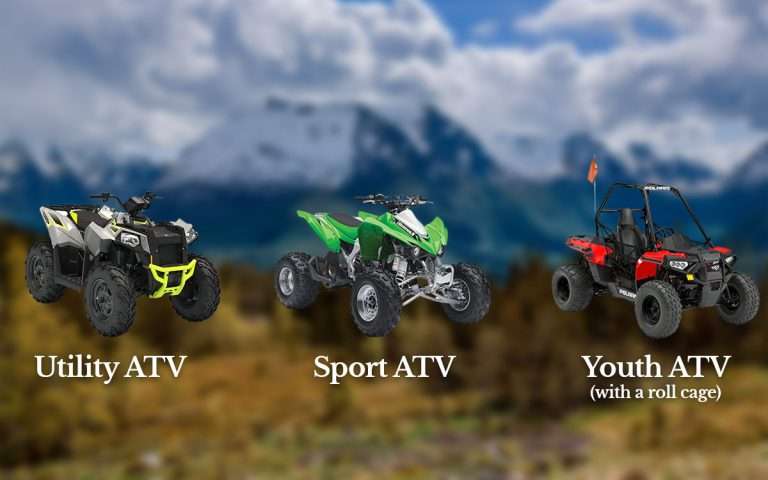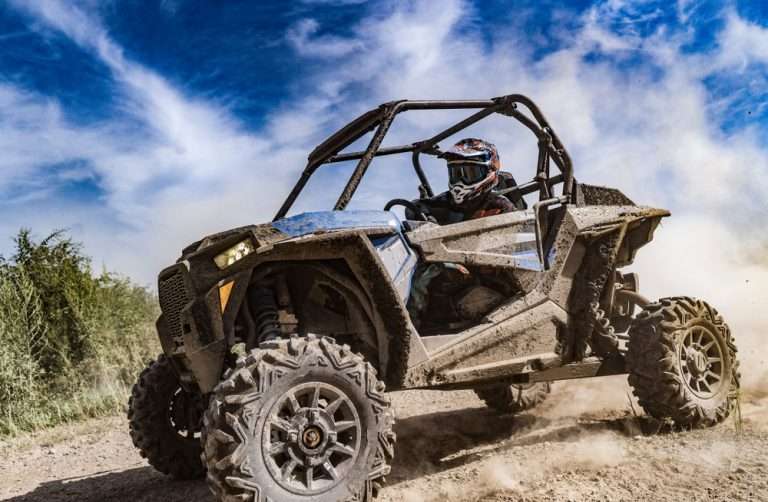There are various types of ATVs, each with its own weight category. So if you are new to the ATV world, you may wonder how much they weigh to figure out better whether it is the right vehicle for you. Or, perhaps, you need to figure out if you can successfully tow your new ATV off the lot.
The average weight of an ATV is 700 lbs; depending on the model, the number can vary between 220 and 1170 pounds. When you note the weight, keep in mind it will either be dry or wet. In addition, any wet weight considers a full tank of gasoline, oil, and other fluids.
The dry weight of a vehicle considers nothing besides the ATV. When looking at the specs of a vehicle, it will tell you the weight and whether it is dry or not.
| ATV Type | Average Weight |
| Youth | 265 lbs |
| Entry Level | 365 lbs |
| Sport | 400 lbs |
| Utility | 550 lbs |
| High-Performance | 650 lbs |
| Side-by-Side | 750 lbs |
Keep reading to learn more about how much an ATV weighs, including details on various types of ATVs, including side-by-sides, youth, utility, and sport.
Table of Contents
What Are the Different Types of ATVs?
This article will discuss the different types of ATVs and their average weight. Remember, an ATV’s weight is often listed as dry or wet, depending on a few factors. For instance, the dry weight of an ATV doesn’t include fluids, passengers, or cargo.
When reading about the different types of ATVs, you should assume the weight listed is dry unless otherwise stated. However, it is good to know the wet weight since that is what it will be while you are driving.
An ATV’s weight is primarily based on its engine size, so the bigger the engine, the bigger the vehicle.
Youth ATV
Youth ATVs are built for children and usually go at lower speeds for safety and security. In addition, you can customize Youth ATVs to your child’s experience level and size. For example, the standard engine sizes for youth ATVs range between 50cc – 90cc.
As your child gets older, they can handle a larger engine, but younger children and beginners should stick to the smaller size. On average, the weight of a youth ATV is about 265 pounds, with the largest being 278 pounds and the smallest being 249 pounds.
Youth ATVs are specially built for kids ages 6-12, so they undoubtedly will be lighter in weight. Also, since there aren’t many add-ons for youth ATVs, you don’t have excessive accessories adding to the weight.
You’ll also find youth ATVs similar to cars, equipped with seat belts, a steering wheel, and foot pedals. Youth ATVs usually come with electric starts and automatic clutches, which help kids learn how to drive ATVs.

You will likely find the wet weight of a youth ATV around 265 lbs, with a dry weight of 225 lbs. But, of course, this varies by brand.
Finally, youth ATVs have a speed limiter to ensure your kids stay safe. They also have an automatic shut-off if the driver falls off.
Entry Level ATV
An entry-level ATV is ideal for a child over 12 years old who still isn’t large enough to drive a regular-sized ATV.
While they are similar to youth ATVs, they are slightly bigger, allowing more space for the driver. The standard engine sizes for entry-level ATVs vary between 125cc – 250cc.
In addition, entry-level ATVs are well-suited for someone who hasn’t driven an ATV. -As a result, entry-level ATVs are often single-cylinder, and their power won’t overtake a beginner.
The average weight of an entry-level ATV is 365 lbs if you ride a 200cc. The largest entry-level ATV weighs 425 lbs, while the smallest comes in at 250 lbs, the Yamaha Blaster.
While entry-level ATVs come in sport or utility, they still are meant for beginners. Their small size and less intense engine make them easier to handle. In addition, you can find similar safety features on the entry-level ATV as you would on the youth models.
You can use an entry-level ATV for work or recreational purposes, and they can usually handle various terrains. Generally, the entry-level ATV is a good vehicle for someone who isn’t ready for a full-sized ATV.
Sport ATV
Sport ATVs are built for speed and are perfect for driving on mountainsides, roaming trails, and over rough terrain. If you are looking for a powerful ATV with a firm suspension, the sport ATV is likely the best fit for you. Sport ATVs are also sporty looking and aerodynamic.
The engine size of a sport ATV varies between 70cc – 700cc, with the average weight being 400 lbs. You’ll notice it’s a large range for sport ATVs, so if you are looking for something in the middle, opt for an ATV with around 400cc.
Despite having a powerful engine, sport ATVs remain the smaller size. For example, one of the smallest sport ATVs is the Yamaha YFZ 450, weighing 350 lbs. On the other hand, the Yamaha Raptor 700R is a powerful beast that weighs 422 lbs.
But, if you are looking for a heavier sports vehicle, check out the Arctic Cat 400 4×4, which comes in at 400 4×4. Remember, sport ATVs are meant for speed, so the heavier you get, you will see a reduction in top speeds.
In addition to having less weight, sports ATVs can make their way through dunes, swamps, and forests. Generally, sports ATVs are built to be lighter and smaller.
Also, sports ATVs can navigate through tight turns and are ideal for racing and jumping.

Utility ATV
Utility ATVs are built for more demanding jobs and typically come equipped with towing hitches and storage racks. They likely are the best fit for you if you require an ATV for construction or farming.
The engine of a utility ATV is typically between 450cc – 1100cc, making it one of the largest on the market. On average, a utility ATV weighs 550 lbs. However, it will vary depending on your engine size.
If you are looking for a utility ATV for the farm or around your house, you are probably safe with one with 550cc – 600cc.
One of the largest utility ATVs you will find is the Polaris Sportsman 450, coming in at 696. However, as the engine gets better, so does the weight. For example, the newer Can-Am Outlander Max Limited 1000R comes in at 900 lbs.
In addition, you can use utility ATVs for snow plowing, hunting, fishing, or camping. While they aren’t as powerful as the sport ATV, you will appreciate their ability to navigate over rough terrain.
Remember, utility ATVs aren’t meant for speed; the bigger you go, the slower it will be. However, utility ATVs have a stable ride and sizeable towing capacity.

High-Performance ATV
High-performance ATVs are at the top of their class because of their powerful engines and ability to face the most challenging terrain. In addition, users appreciate that speed and power aren’t sacrificed in the high-performance ATV, even when going over challenging landscapes.
These powerful ATVs have an engine size between 350cc – 800cc and have an average weight of 650 lbs, but this can vary significantly based on engine size.
High-performance ATVs also offer a smooth ride with advanced suspension, making them incredible ATVs to drive.
One of the most powerful high-performance ATVs is the Polaris Scrambler 850, with a dry weight of 735 lbs.
High-performance ATVs typically come with two seats, allowing the driver to bring a friend. Also, higher-end models offer an array of upgrades, including LED light bars, speaker, kits, and extra storage space.
High-performance vehicles are excellent for someone who needs a vehicle tough enough to travel through rough terrain but also offers a comfortable ride.
While high-performance ATVs might come with a higher price tag, you get what you pay for, and you’ll appreciate riding the vehicle for years to come.

Side-by-Side ATV
As the name implies, side-by-side ATVs are vehicles where two people can sit next together. For example, you can compare the seating to that of a regular car or truck and find pedals, a steering wheel, and a gear shift.
In addition, you’ll find the engine size in side-by-side ATVs can vary between 700cc – 1100 cc, mainly due to the extra weight from the frame. Generally, side-by-side ATVs are the heaviest you will find due to the additional seating, with an average weight of 1,300 lbs.
For example, one of the largest side-by-side ATVs is the Yamaha Wolverine RMAX 1000, coming in at 1,845 lbs. On the other hand, the Can-Am 1000 weighs less at 1,271 lbs.
But, 2022 brought one of the lightest side-by-side ATVs to date with the introduction of the Polaris RZR trail, weighing only 996 lbs.
However, the weight is significantly impacted by how many extra features you have and which model you choose.
Side-by-side ATVs also have safety features like roll cages and seatbelts, which aren’t standard on all ATVs. If you choose to add anything additional, remember it will begin to weigh down your vehicle.
With the ability to carry an extra passenger and safety features, it’s no question the side-by-side ATV remains a popular choice amongst consumers.
It’s best to understand the average weight of various ATV types, then worry about what each ATV weighs. So, for example, if you’re looking for a lightweight ATV, you should know that the youth, entry-level, and sports types best suit your needs.
However, if you want something rugged and tough, you’ll likely pursue the utility or high-performance ATV. Remember to consider whether the weight is wet or dry, as it will affect the overall number.
If you are interested in knowing the weight of an ATV because you must tow it, you should consider the wet weight because it will include gas and oils.
ATV Weight Based On CCs
| CCs | Average Weight |
| 50cc | 215 lbs |
| 70cc | 250 lbs |
| 90cc | 265 lbs |
| 200cc | 365 lbs |
| 250cc | 410 lbs |
| 300cc | 510 lbs |
| 350cc | 490 lbs |
| 400cc | 495 lbs |
| 450cc | 520 lbs |
| 500cc | 630 lbs |
| 650cc | 635 lbs |
| 700cc | 645 lbs |
| 800cc | 715 lbs |
| 1000cc | 840 lbs |
Remember, the numbers listed average weights and can vary by brand. For example, the 300cc average weight doesn’t match the trend because specific models weigh less.
Conclusion
The weight of an ATV varies depending on the type, with youth and entry-level ATVs weighing the least. On the other hand, utility and high-performance ATVs come with a higher weight, but generally, the weight can vary from one brand to the next.
You will also notice the size of the ATV’s engine plays a large part in the weight. Also, any added upgrades will increase the ATV’s weight and could also effect your 4×4’s speed.
In addition, be sure to note where a listed weight is dry or wet, as liquids like oil and gas can affect the overall number.
Generally, having a heavier ATV means it will run slower than a lighter ATV, but heavier ATVs tend to do better over rough terrain and withstand some damage.

I’m William Guzenski, ASE certified master automobile technician & automotive expert. I love to attend race events and car shows throughout the country. I also loves to travel 40-foot motorhome, exploring abandoned mines and ghost towns. I’m currently building another car for Bonneville Salt Flats and will be campaigning a drag car at several events.


